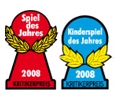|
The main “Kinderspiel des Jahres 2009” award goes to “Das magische Labyrinth”
by Dirk Baumann and Drei Magier Spiele
“Das magische Labyrinth” (The magical maze) exerts magnetic attraction over children as well as adults. “Magician apprentices” are moved along the game board searching for magical objects and secret symbols. But now and then the hidden maze makes the magnetic apprentices bump against invisible walls. Players have to watch carefully and keep all hidden obstacles in mind to find their way through the magical maze. The game stands out due to artful designed play mechanisms and stimulative elements.
Even assembling the magical maze can be considered a little construction game. You have to take the square board out of the box and fit the 24 walls (made of sturdy wood) into the slots of the maze grit. Now place the board back onto the box and enjoy the great challenge of an invisible underground maze.
 |
|
The “magical apprentices” or rather the magnetic figures are placed onto one of the starting squares at the corners. Players carefully insert metal balls from underneath until each figure is magnetically attached to a ball. Now draw a “magical symbol” from the bag and place it onto the board. Each player tries to be the first to reach the symbol. Obviously an easy enough task as there seems to be nothing in their way.
It’s your turn: Throw the dice and move your magician along the squares. That’s theory. But in reality your apprentice will most certainly bump against an invisible wall – in the truest sense of the word. That’s how the magical underground maze reveals its perfidy. When your token bumps against an underground wall, it will loose the metal ball and has to go back to the starting point. It’s essential to remember all the places where you – and your fellow players! – failed, i.e. bumped into an invisible obstacle. All players are always actively involved into the game as watching your fellow players’ activities renders valuable information for your own strategy. When a magician successfully moves around the obstacles without losing the magnetic ball, they may start from where they got when it is their turn again. |
When a player reaches the symbol, they get the chip and place another one onto the board. The game is over as soon as a player has won five symbols.
The clearly designed book of rules is easy to read and leaves no questions unanswered; by the way, it is also outstanding in beautiful design.
|
There’s no need for long explanations if you spontaneously decide to join in – you will soon understand the rules and become a full fledged player. And even experienced players do not have a head start as winning depends only on your memory.
"The magical maze" is not only flexible due to the change of wall positions but also due to the change in difficulty. How often you bump into invisible walls not only depend on your memory but also on how many walls are placed into the maze. When you play with young children, you may as well take 6 to 7 walls less. When playing only with grown-ups you should best insert all the walls. |
|
 |
Playing only with grown-ups? Yes, indeed. "The magical maze" not only appeals to children, it also fuels the ambition of grown-ups to move their magicians most cunningly along the hidden walls. | 

